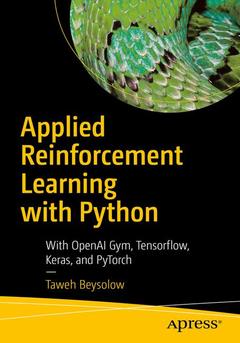Description
Applied Reinforcement Learning with Python, 1st ed.
With OpenAI Gym, Tensorflow, and Keras
Author: Beysolow II Taweh
Language: English
Subjects for Applied Reinforcement Learning with Python:
Support: Print on demand
Description
/li>Contents
/li>Biography
/li>Comment
/li>
Delve into the world of reinforcement learning algorithms and apply them to different use-cases via Python. This book covers important topics such as policy gradients and Q learning, and utilizes frameworks such as Tensorflow, Keras, and OpenAI Gym.
Applied Reinforcement Learning with Python introduces you to the theory behind reinforcement learning (RL) algorithms and the code that will be used to implement them. You will take a guided tour through features of OpenAI Gym, from utilizing standard libraries to creating your own environments, then discover how to frame reinforcement learning problems so you can research, develop, and deploy RL-based solutions.
What You'll Learn
- Implement reinforcement learning with Python
- Work with AI frameworks such as OpenAI Gym, Tensorflow, and Keras
- Deploy and train reinforcement learning?based solutions via cloud resources
- Apply practical applications of reinforcement learning
Who This Book Is For
Data scientists, machine learning engineers and software engineers familiar with machine learning and deep learning concepts.
Understand how to package and deploy solutions in Python that utilize deep learning
Includes specific topics such as Q learning and deep reinforcement-learning
Covers the latest reinforcement learning packages




